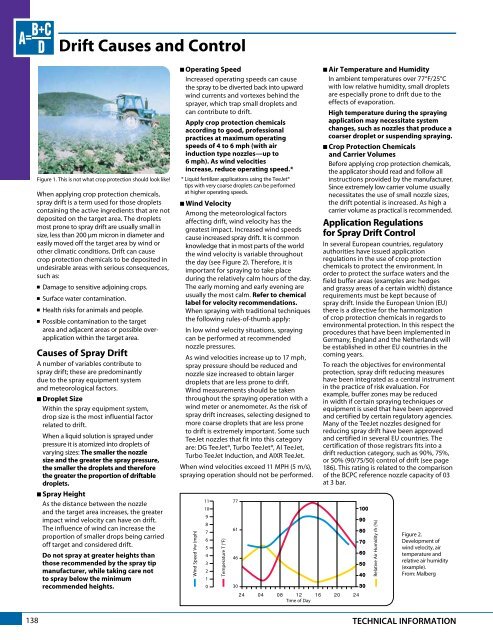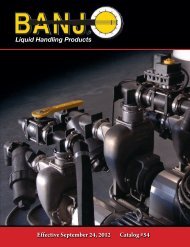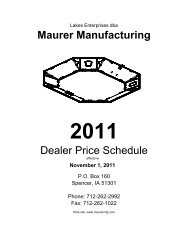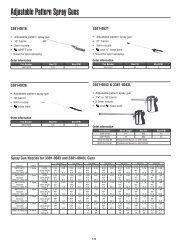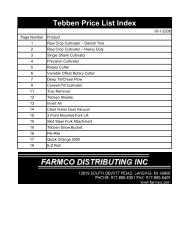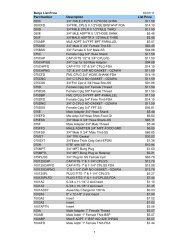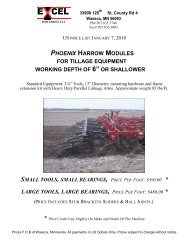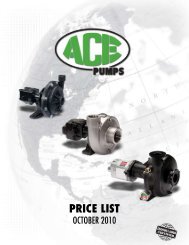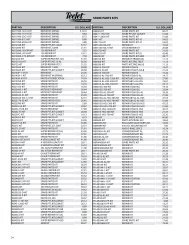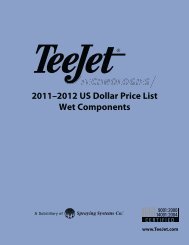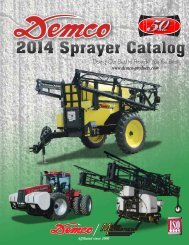Teejet Catalog 51 - Farmco Distributing Inc
Teejet Catalog 51 - Farmco Distributing Inc
Teejet Catalog 51 - Farmco Distributing Inc
You also want an ePaper? Increase the reach of your titles
YUMPU automatically turns print PDFs into web optimized ePapers that Google loves.
Drift Causes and Control<br />
Figure 1. This is not what crop protection should look like!<br />
When applying crop protection chemicals,<br />
spray drift is a term used for those droplets<br />
containing the active ingredients that are not<br />
deposited on the target area. The droplets<br />
most prone to spray drift are usually small in<br />
size, less than 200 µm micron in diameter and<br />
easily moved off the target area by wind or<br />
other climatic conditions. Drift can cause<br />
crop protection chemicals to be deposited in<br />
undesirable areas with serious consequences,<br />
such as:<br />
n Damage to sensitive adjoining crops.<br />
n Surface water contamination.<br />
n Health risks for animals and people.<br />
n Possible contamination to the target<br />
area and adjacent areas or possible overapplication<br />
within the target area.<br />
Causes of Spray Drift<br />
A number of variables contribute to<br />
spray drift; these are predominantly<br />
due to the spray equipment system<br />
and meteorological factors.<br />
nDroplet Size<br />
Within the spray equipment system,<br />
drop size is the most influential factor<br />
related to drift.<br />
When a liquid solution is sprayed under<br />
pressure it is atomized into droplets of<br />
varying sizes: The smaller the nozzle<br />
size and the greater the spray pres sure,<br />
the smaller the droplets and therefore<br />
the greater the proportion of driftable<br />
droplets.<br />
nSpray Height<br />
As the distance between the nozzle<br />
and the target area increases, the greater<br />
impact wind velocity can have on drift.<br />
The influence of wind can increase the<br />
proportion of smaller drops being carried<br />
off target and considered drift.<br />
Do not spray at greater heights than<br />
those recommended by the spray tip<br />
manufacturer, while taking care not<br />
to spray below the minimum<br />
recom mended heights.<br />
nOperating Speed<br />
<strong>Inc</strong>reased operating speeds can cause<br />
the spray to be diverted back into upward<br />
wind currents and vortexes behind the<br />
sprayer, which trap small droplets and<br />
can contribute to drift.<br />
Apply crop protection chemicals<br />
according to good, professional<br />
practices at maximum operating<br />
speeds of 4 to 6 mph (with air<br />
induction type nozzles—up to<br />
6 mph). As wind velocities<br />
increase, reduce operating speed.*<br />
* Liquid fertilizer applications using the TeeJet®<br />
tips with very coarse droplets can be performed<br />
at higher operating speeds.<br />
nWind Velocity<br />
Among the meteorological factors<br />
affecting drift, wind velocity has the<br />
greatest impact. <strong>Inc</strong>reased wind speeds<br />
cause increased spray drift. It is common<br />
knowledge that in most parts of the world<br />
the wind velocity is variable throughout<br />
the day (see Figure 2). Therefore, it is<br />
important for spraying to take place<br />
during the relatively calm hours of the day.<br />
The early morning and early evening are<br />
usually the most calm. Refer to chemical<br />
label for velocity recom menda tions.<br />
When spraying with traditional techniques<br />
the following rules-of-thumb apply:<br />
In low wind velocity situations, spraying<br />
can be performed at recommended<br />
nozzle pressures.<br />
As wind velocities increase up to 17 mph,<br />
spray pressure should be reduced and<br />
nozzle size increased to obtain larger<br />
droplets that are less prone to drift.<br />
Wind measurements should be taken<br />
throughout the spraying operation with a<br />
wind meter or anemometer. As the risk of<br />
spray drift increases, selecting designed to<br />
more coarse droplets that are less prone<br />
to drift is extremely important. Some such<br />
TeeJet nozzles that fit into this category<br />
are: DG TeeJet®, Turbo TeeJet®, AI TeeJet,<br />
Turbo TeeJet Induction, and AIXR TeeJet.<br />
When wind velocities exceed 11 MPH (5 m/s),<br />
spraying operation should not be performed.<br />
Wind Speed Vw (mph)<br />
11<br />
10<br />
9<br />
8<br />
7<br />
6<br />
5<br />
4<br />
3<br />
2<br />
1<br />
0<br />
Temperature T (°F)<br />
77<br />
61<br />
46<br />
30<br />
nAir Temperature and Humidity<br />
In ambient temperatures over 77°F/25°C<br />
with low relative humidity, small droplets<br />
are especially prone to drift due to the<br />
effects of evaporation.<br />
High temperature during the spraying<br />
application may necessitate system<br />
changes, such as nozzles that produce a<br />
coarser droplet or suspending spraying.<br />
nCrop Protection Chemicals<br />
and Carrier Volumes<br />
Before applying crop protection chemicals,<br />
the applicator should read and follow all<br />
instructions provided by the manufacturer.<br />
Since extremely low carrier volume usually<br />
necessitates the use of small nozzle sizes,<br />
the drift potential is increased. As high a<br />
carrier volume as practical is recommended.<br />
Application Regulations<br />
for Spray Drift Control<br />
In several European countries, regulatory<br />
authorities have issued application<br />
regulations in the use of crop protection<br />
chemicals to protect the environment. In<br />
order to protect the surface waters and the<br />
field buffer areas (examples are: hedges<br />
and grassy areas of a certain width) distance<br />
requirements must be kept because of<br />
spray drift. Inside the European Union (EU)<br />
there is a directive for the harmonization<br />
of crop protection chemicals in regards to<br />
environmental protection. In this respect the<br />
procedures that have been implemented in<br />
Germany, England and the Netherlands will<br />
be established in other EU countries in the<br />
coming years.<br />
To reach the objectives for environmental<br />
protection, spray drift reducing measures<br />
have been integrated as a central instrument<br />
in the practice of risk evaluation. For<br />
example, buffer zones may be reduced<br />
in width if certain spraying techniques or<br />
equipment is used that have been approved<br />
and certified by certain regulatory agencies.<br />
Many of the TeeJet nozzles designed for<br />
reducing spray drift have been approved<br />
and certified in several EU countries. The<br />
certification of those registrars fits into a<br />
drift reduction category, such as 90%, 75%,<br />
or 50% (90/75/50) control of drift (see page<br />
186). This rating is related to the comparison<br />
of the BCPC reference nozzle capacity of 03<br />
at 3 bar.<br />
Relative Air Humidity rh (%)<br />
Figure 2.<br />
Development of<br />
wind velocity, air<br />
temperature and<br />
relative air humidity<br />
(example).<br />
From: Malberg<br />
Time of Day<br />
138<br />
TECHNICAL INFORMATION


